Global Economy: Samsung's Marketing Strategies in India and the UK
VerifiedAdded on 2023/06/15
|23
|4073
|330
Report
AI Summary
This report provides a comprehensive analysis of Samsung's marketing strategies within the global economies of India and the UK. It begins with a business overview of Samsung, highlighting its global leadership in telecommunications and digital media. The report delves into the market structures of both India and the UK, noting India's oligopolistic competition and the UK's dominance by Apple and other smartphone companies. A comparative analysis of macroeconomic indicators, including GDP growth, inflation rates, unemployment rates, government structural balances, and balance of payments, is presented to assess the economic environments in both countries. Furthermore, the report examines the monetary and fiscal policies of India and the UK, evaluating their impact on Samsung's economic activity, including consumer spending and industrialization. The report concludes with an analysis of foreign trade policies, providing a holistic view of the factors influencing Samsung's operations in these key markets.
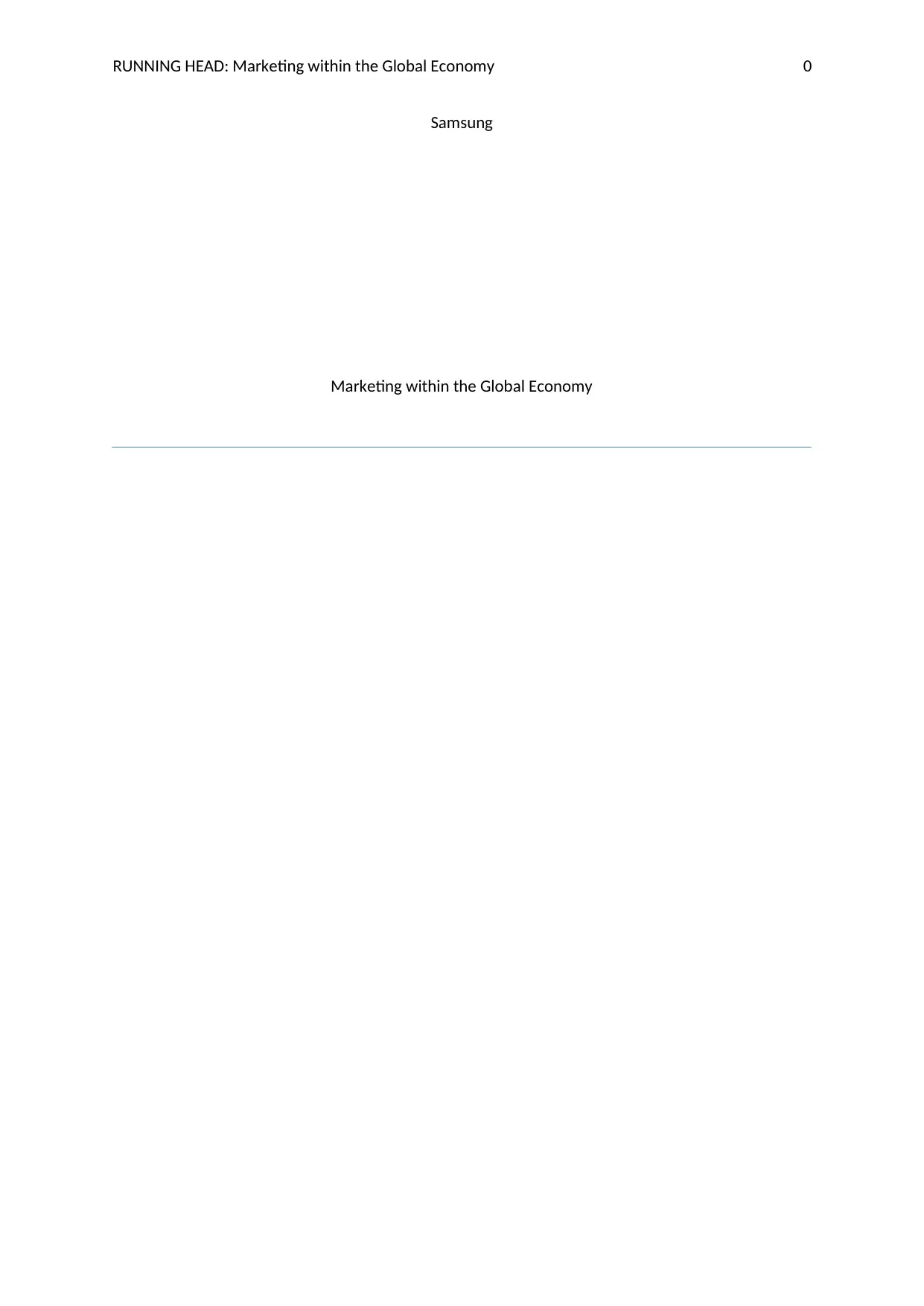
RUNNING HEAD: Marketing within the Global Economy 0
Samsung
Marketing within the Global Economy
Samsung
Marketing within the Global Economy
Paraphrase This Document
Need a fresh take? Get an instant paraphrase of this document with our AI Paraphraser
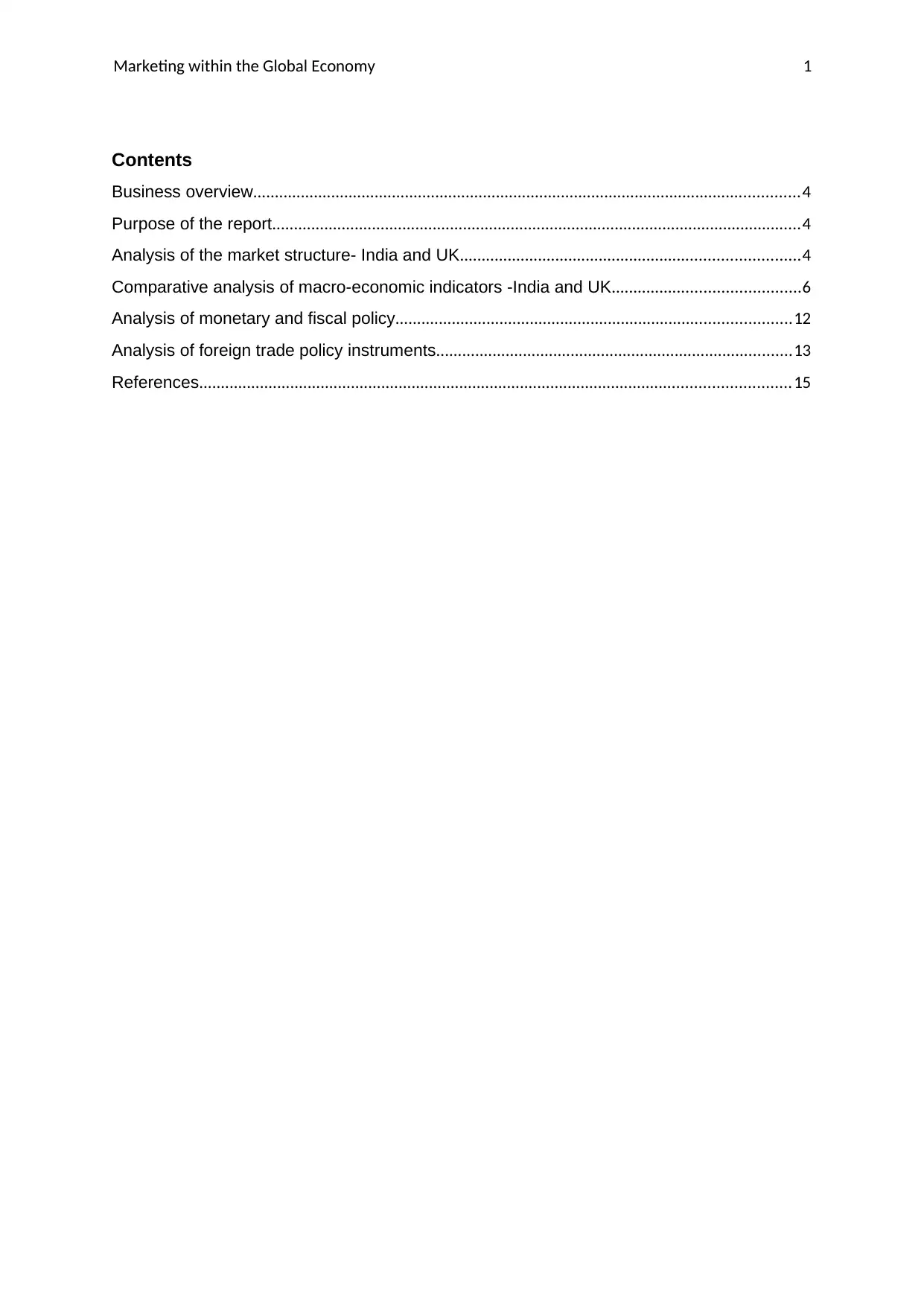
Marketing within the Global Economy 1
Contents
Business overview..............................................................................................................................4
Purpose of the report..........................................................................................................................4
Analysis of the market structure- India and UK..............................................................................4
Comparative analysis of macro-economic indicators -India and UK...........................................6
Analysis of monetary and fiscal policy...........................................................................................12
Analysis of foreign trade policy instruments..................................................................................13
References........................................................................................................................................15
Contents
Business overview..............................................................................................................................4
Purpose of the report..........................................................................................................................4
Analysis of the market structure- India and UK..............................................................................4
Comparative analysis of macro-economic indicators -India and UK...........................................6
Analysis of monetary and fiscal policy...........................................................................................12
Analysis of foreign trade policy instruments..................................................................................13
References........................................................................................................................................15
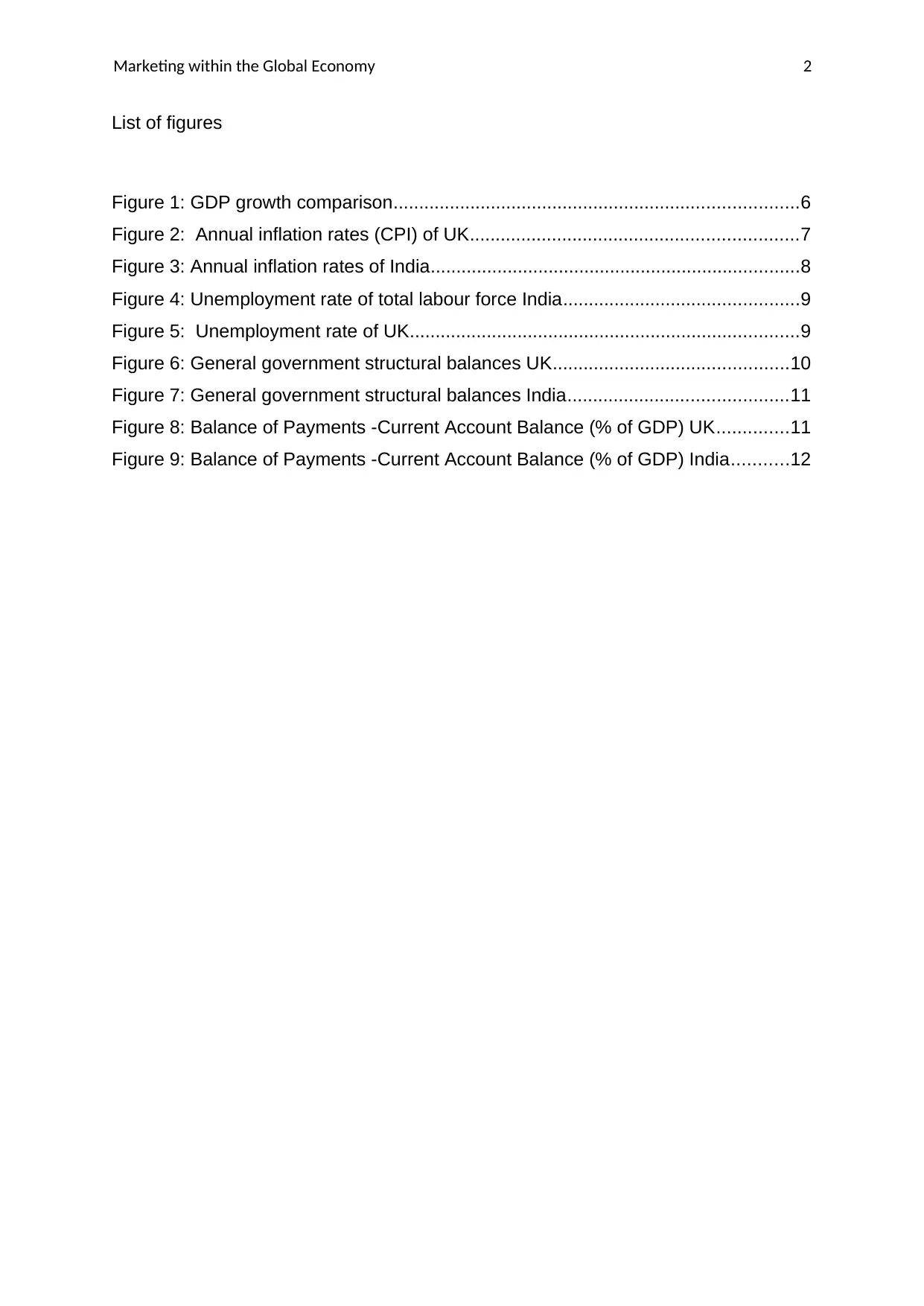
Marketing within the Global Economy 2
List of figures
Figure 1: GDP growth comparison...............................................................................6
Figure 2: Annual inflation rates (CPI) of UK................................................................7
Figure 3: Annual inflation rates of India........................................................................8
Figure 4: Unemployment rate of total labour force India..............................................9
Figure 5: Unemployment rate of UK............................................................................9
Figure 6: General government structural balances UK..............................................10
Figure 7: General government structural balances India...........................................11
Figure 8: Balance of Payments -Current Account Balance (% of GDP) UK..............11
Figure 9: Balance of Payments -Current Account Balance (% of GDP) India...........12
List of figures
Figure 1: GDP growth comparison...............................................................................6
Figure 2: Annual inflation rates (CPI) of UK................................................................7
Figure 3: Annual inflation rates of India........................................................................8
Figure 4: Unemployment rate of total labour force India..............................................9
Figure 5: Unemployment rate of UK............................................................................9
Figure 6: General government structural balances UK..............................................10
Figure 7: General government structural balances India...........................................11
Figure 8: Balance of Payments -Current Account Balance (% of GDP) UK..............11
Figure 9: Balance of Payments -Current Account Balance (% of GDP) India...........12
⊘ This is a preview!⊘
Do you want full access?
Subscribe today to unlock all pages.

Trusted by 1+ million students worldwide
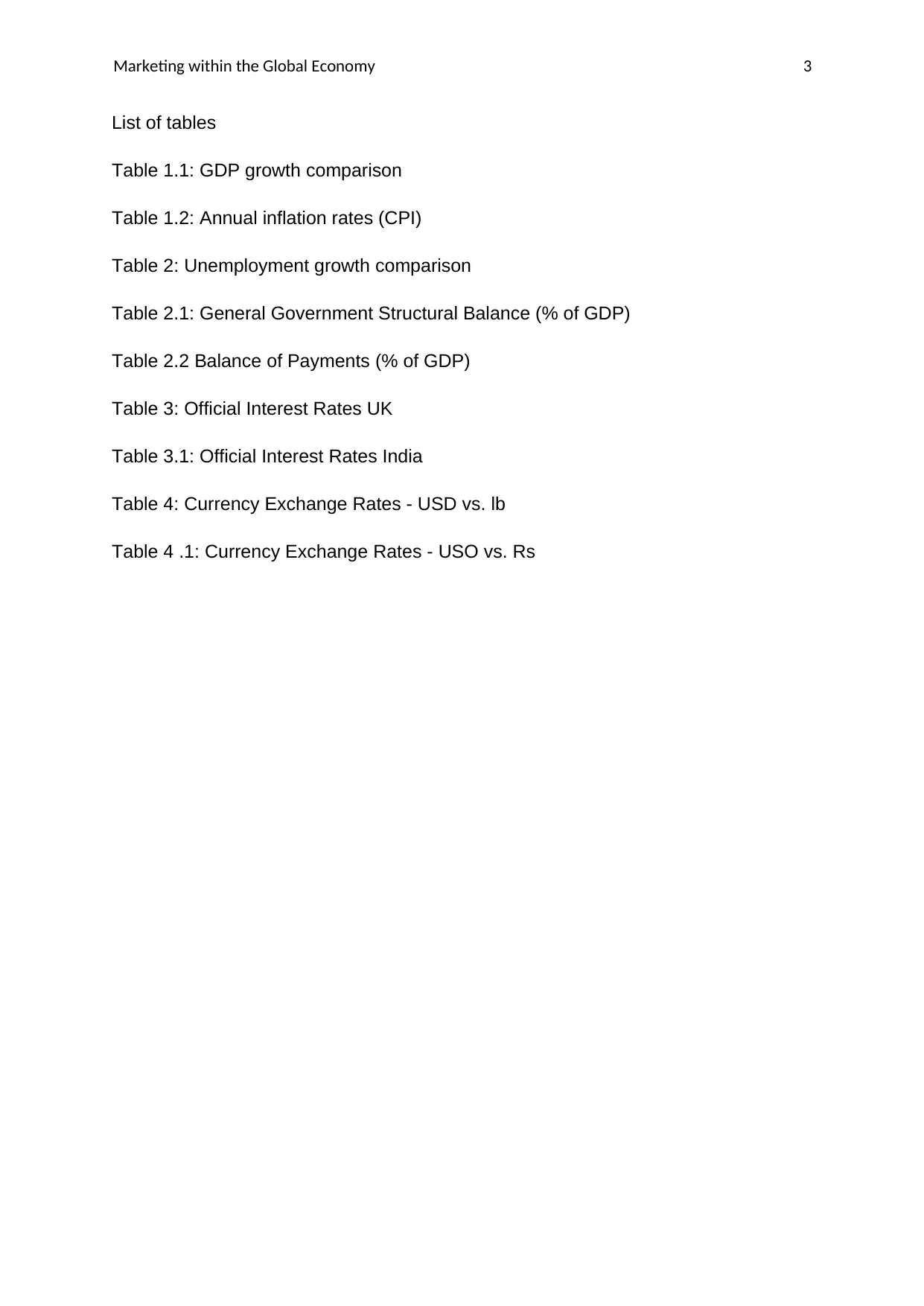
Marketing within the Global Economy 3
List of tables
Table 1.1: GDP growth comparison
Table 1.2: Annual inflation rates (CPI)
Table 2: Unemployment growth comparison
Table 2.1: General Government Structural Balance (% of GDP)
Table 2.2 Balance of Payments (% of GDP)
Table 3: Official Interest Rates UK
Table 3.1: Official Interest Rates India
Table 4: Currency Exchange Rates - USD vs. lb
Table 4 .1: Currency Exchange Rates - USO vs. Rs
List of tables
Table 1.1: GDP growth comparison
Table 1.2: Annual inflation rates (CPI)
Table 2: Unemployment growth comparison
Table 2.1: General Government Structural Balance (% of GDP)
Table 2.2 Balance of Payments (% of GDP)
Table 3: Official Interest Rates UK
Table 3.1: Official Interest Rates India
Table 4: Currency Exchange Rates - USD vs. lb
Table 4 .1: Currency Exchange Rates - USO vs. Rs
Paraphrase This Document
Need a fresh take? Get an instant paraphrase of this document with our AI Paraphraser
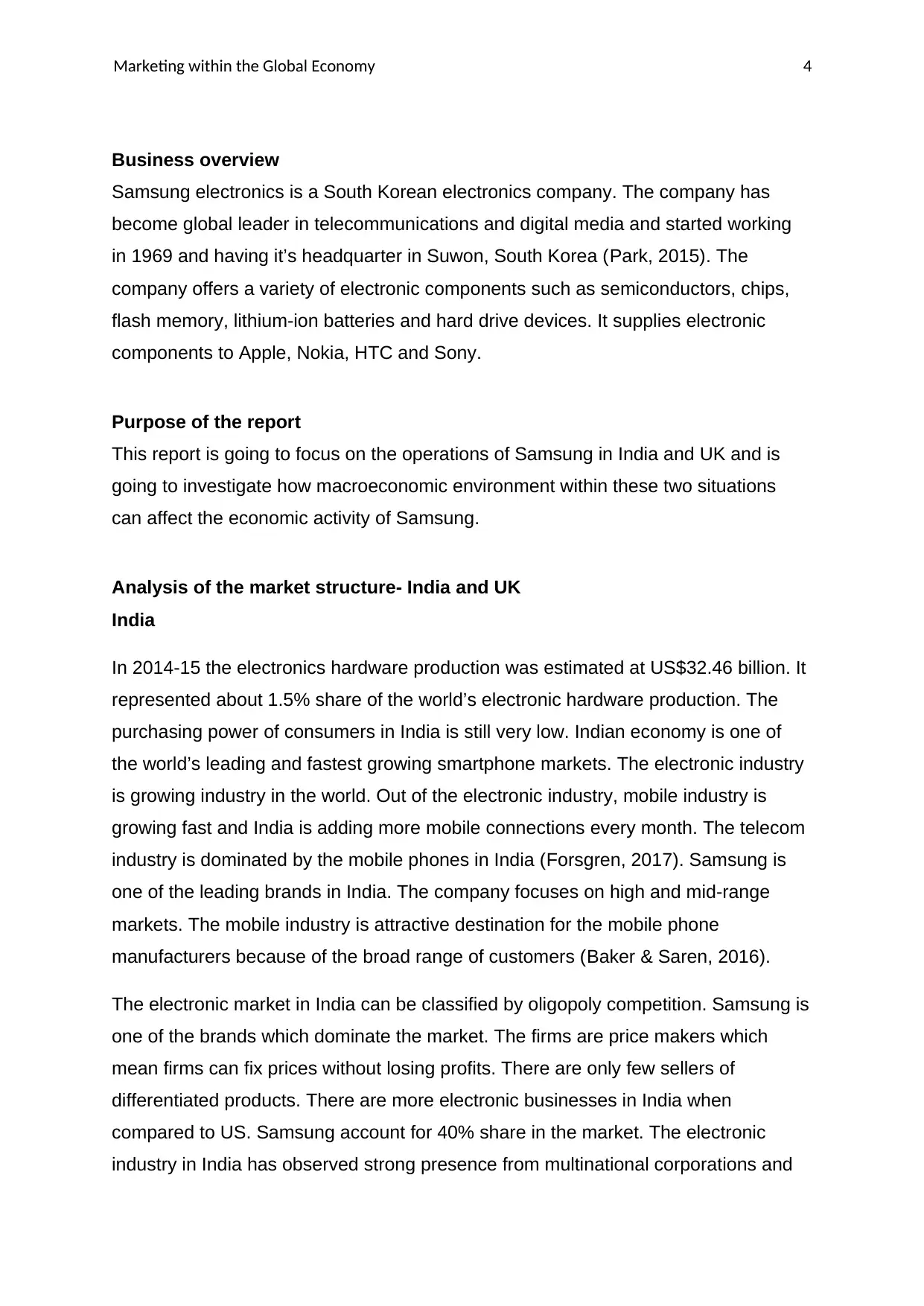
Marketing within the Global Economy 4
Business overview
Samsung electronics is a South Korean electronics company. The company has
become global leader in telecommunications and digital media and started working
in 1969 and having it’s headquarter in Suwon, South Korea (Park, 2015). The
company offers a variety of electronic components such as semiconductors, chips,
flash memory, lithium-ion batteries and hard drive devices. It supplies electronic
components to Apple, Nokia, HTC and Sony.
Purpose of the report
This report is going to focus on the operations of Samsung in India and UK and is
going to investigate how macroeconomic environment within these two situations
can affect the economic activity of Samsung.
Analysis of the market structure- India and UK
India
In 2014-15 the electronics hardware production was estimated at US$32.46 billion. It
represented about 1.5% share of the world’s electronic hardware production. The
purchasing power of consumers in India is still very low. Indian economy is one of
the world’s leading and fastest growing smartphone markets. The electronic industry
is growing industry in the world. Out of the electronic industry, mobile industry is
growing fast and India is adding more mobile connections every month. The telecom
industry is dominated by the mobile phones in India (Forsgren, 2017). Samsung is
one of the leading brands in India. The company focuses on high and mid-range
markets. The mobile industry is attractive destination for the mobile phone
manufacturers because of the broad range of customers (Baker & Saren, 2016).
The electronic market in India can be classified by oligopoly competition. Samsung is
one of the brands which dominate the market. The firms are price makers which
mean firms can fix prices without losing profits. There are only few sellers of
differentiated products. There are more electronic businesses in India when
compared to US. Samsung account for 40% share in the market. The electronic
industry in India has observed strong presence from multinational corporations and
Business overview
Samsung electronics is a South Korean electronics company. The company has
become global leader in telecommunications and digital media and started working
in 1969 and having it’s headquarter in Suwon, South Korea (Park, 2015). The
company offers a variety of electronic components such as semiconductors, chips,
flash memory, lithium-ion batteries and hard drive devices. It supplies electronic
components to Apple, Nokia, HTC and Sony.
Purpose of the report
This report is going to focus on the operations of Samsung in India and UK and is
going to investigate how macroeconomic environment within these two situations
can affect the economic activity of Samsung.
Analysis of the market structure- India and UK
India
In 2014-15 the electronics hardware production was estimated at US$32.46 billion. It
represented about 1.5% share of the world’s electronic hardware production. The
purchasing power of consumers in India is still very low. Indian economy is one of
the world’s leading and fastest growing smartphone markets. The electronic industry
is growing industry in the world. Out of the electronic industry, mobile industry is
growing fast and India is adding more mobile connections every month. The telecom
industry is dominated by the mobile phones in India (Forsgren, 2017). Samsung is
one of the leading brands in India. The company focuses on high and mid-range
markets. The mobile industry is attractive destination for the mobile phone
manufacturers because of the broad range of customers (Baker & Saren, 2016).
The electronic market in India can be classified by oligopoly competition. Samsung is
one of the brands which dominate the market. The firms are price makers which
mean firms can fix prices without losing profits. There are only few sellers of
differentiated products. There are more electronic businesses in India when
compared to US. Samsung account for 40% share in the market. The electronic
industry in India has observed strong presence from multinational corporations and
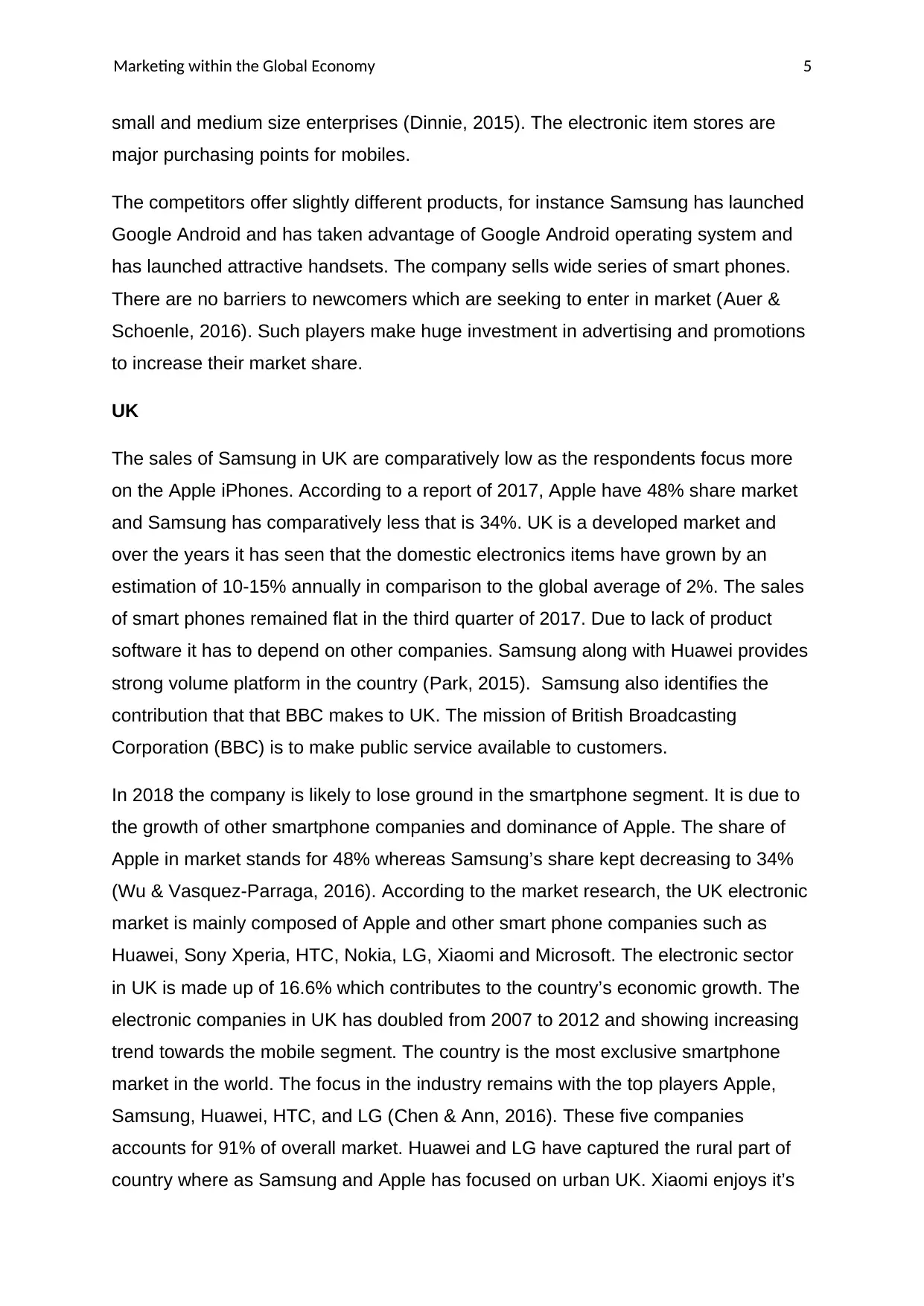
Marketing within the Global Economy 5
small and medium size enterprises (Dinnie, 2015). The electronic item stores are
major purchasing points for mobiles.
The competitors offer slightly different products, for instance Samsung has launched
Google Android and has taken advantage of Google Android operating system and
has launched attractive handsets. The company sells wide series of smart phones.
There are no barriers to newcomers which are seeking to enter in market (Auer &
Schoenle, 2016). Such players make huge investment in advertising and promotions
to increase their market share.
UK
The sales of Samsung in UK are comparatively low as the respondents focus more
on the Apple iPhones. According to a report of 2017, Apple have 48% share market
and Samsung has comparatively less that is 34%. UK is a developed market and
over the years it has seen that the domestic electronics items have grown by an
estimation of 10-15% annually in comparison to the global average of 2%. The sales
of smart phones remained flat in the third quarter of 2017. Due to lack of product
software it has to depend on other companies. Samsung along with Huawei provides
strong volume platform in the country (Park, 2015). Samsung also identifies the
contribution that that BBC makes to UK. The mission of British Broadcasting
Corporation (BBC) is to make public service available to customers.
In 2018 the company is likely to lose ground in the smartphone segment. It is due to
the growth of other smartphone companies and dominance of Apple. The share of
Apple in market stands for 48% whereas Samsung’s share kept decreasing to 34%
(Wu & Vasquez-Parraga, 2016). According to the market research, the UK electronic
market is mainly composed of Apple and other smart phone companies such as
Huawei, Sony Xperia, HTC, Nokia, LG, Xiaomi and Microsoft. The electronic sector
in UK is made up of 16.6% which contributes to the country’s economic growth. The
electronic companies in UK has doubled from 2007 to 2012 and showing increasing
trend towards the mobile segment. The country is the most exclusive smartphone
market in the world. The focus in the industry remains with the top players Apple,
Samsung, Huawei, HTC, and LG (Chen & Ann, 2016). These five companies
accounts for 91% of overall market. Huawei and LG have captured the rural part of
country where as Samsung and Apple has focused on urban UK. Xiaomi enjoys it’s
small and medium size enterprises (Dinnie, 2015). The electronic item stores are
major purchasing points for mobiles.
The competitors offer slightly different products, for instance Samsung has launched
Google Android and has taken advantage of Google Android operating system and
has launched attractive handsets. The company sells wide series of smart phones.
There are no barriers to newcomers which are seeking to enter in market (Auer &
Schoenle, 2016). Such players make huge investment in advertising and promotions
to increase their market share.
UK
The sales of Samsung in UK are comparatively low as the respondents focus more
on the Apple iPhones. According to a report of 2017, Apple have 48% share market
and Samsung has comparatively less that is 34%. UK is a developed market and
over the years it has seen that the domestic electronics items have grown by an
estimation of 10-15% annually in comparison to the global average of 2%. The sales
of smart phones remained flat in the third quarter of 2017. Due to lack of product
software it has to depend on other companies. Samsung along with Huawei provides
strong volume platform in the country (Park, 2015). Samsung also identifies the
contribution that that BBC makes to UK. The mission of British Broadcasting
Corporation (BBC) is to make public service available to customers.
In 2018 the company is likely to lose ground in the smartphone segment. It is due to
the growth of other smartphone companies and dominance of Apple. The share of
Apple in market stands for 48% whereas Samsung’s share kept decreasing to 34%
(Wu & Vasquez-Parraga, 2016). According to the market research, the UK electronic
market is mainly composed of Apple and other smart phone companies such as
Huawei, Sony Xperia, HTC, Nokia, LG, Xiaomi and Microsoft. The electronic sector
in UK is made up of 16.6% which contributes to the country’s economic growth. The
electronic companies in UK has doubled from 2007 to 2012 and showing increasing
trend towards the mobile segment. The country is the most exclusive smartphone
market in the world. The focus in the industry remains with the top players Apple,
Samsung, Huawei, HTC, and LG (Chen & Ann, 2016). These five companies
accounts for 91% of overall market. Huawei and LG have captured the rural part of
country where as Samsung and Apple has focused on urban UK. Xiaomi enjoys it’s
⊘ This is a preview!⊘
Do you want full access?
Subscribe today to unlock all pages.

Trusted by 1+ million students worldwide
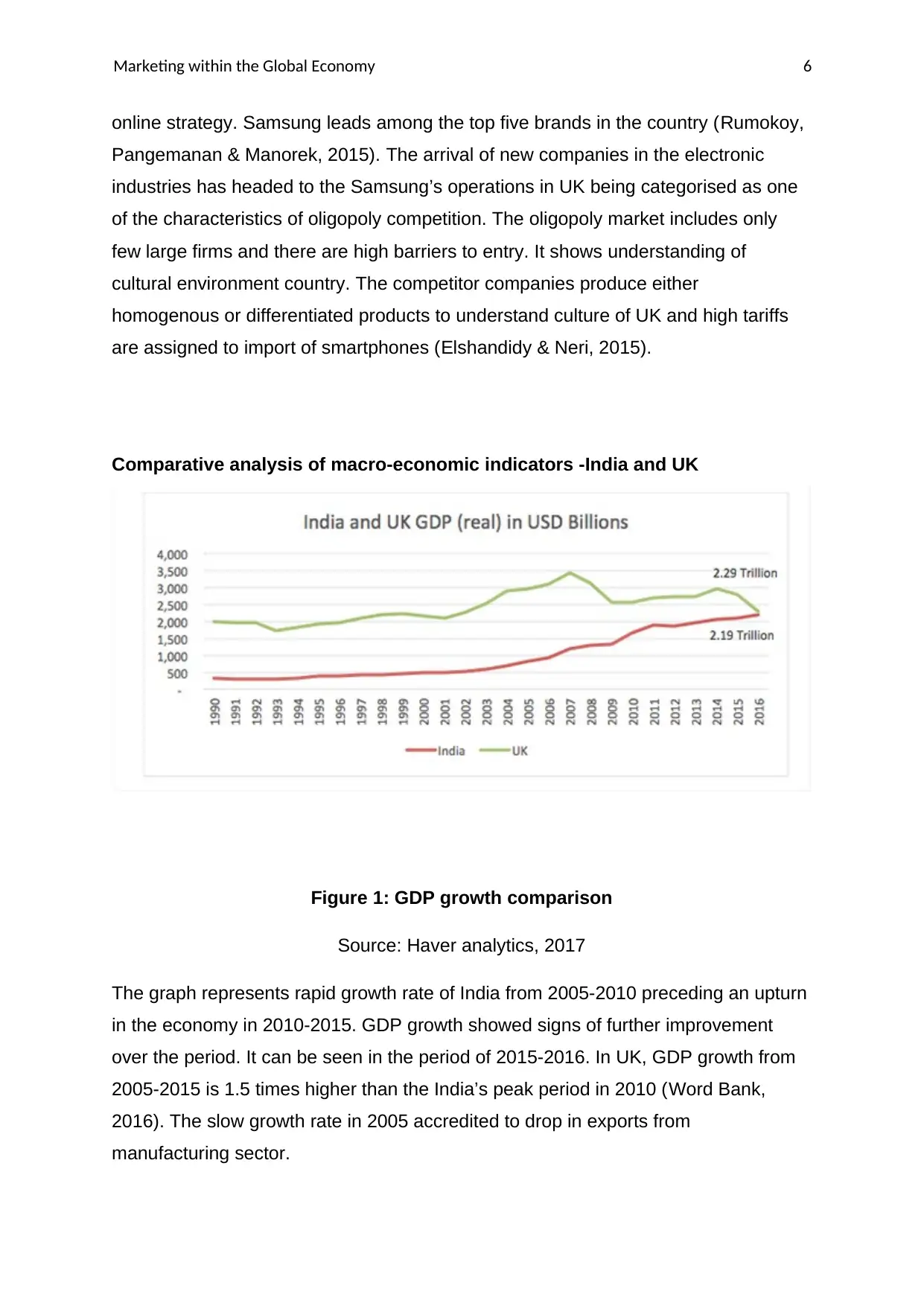
Marketing within the Global Economy 6
online strategy. Samsung leads among the top five brands in the country (Rumokoy,
Pangemanan & Manorek, 2015). The arrival of new companies in the electronic
industries has headed to the Samsung’s operations in UK being categorised as one
of the characteristics of oligopoly competition. The oligopoly market includes only
few large firms and there are high barriers to entry. It shows understanding of
cultural environment country. The competitor companies produce either
homogenous or differentiated products to understand culture of UK and high tariffs
are assigned to import of smartphones (Elshandidy & Neri, 2015).
Comparative analysis of macro-economic indicators -India and UK
Figure 1: GDP growth comparison
Source: Haver analytics, 2017
The graph represents rapid growth rate of India from 2005-2010 preceding an upturn
in the economy in 2010-2015. GDP growth showed signs of further improvement
over the period. It can be seen in the period of 2015-2016. In UK, GDP growth from
2005-2015 is 1.5 times higher than the India’s peak period in 2010 (Word Bank,
2016). The slow growth rate in 2005 accredited to drop in exports from
manufacturing sector.
online strategy. Samsung leads among the top five brands in the country (Rumokoy,
Pangemanan & Manorek, 2015). The arrival of new companies in the electronic
industries has headed to the Samsung’s operations in UK being categorised as one
of the characteristics of oligopoly competition. The oligopoly market includes only
few large firms and there are high barriers to entry. It shows understanding of
cultural environment country. The competitor companies produce either
homogenous or differentiated products to understand culture of UK and high tariffs
are assigned to import of smartphones (Elshandidy & Neri, 2015).
Comparative analysis of macro-economic indicators -India and UK
Figure 1: GDP growth comparison
Source: Haver analytics, 2017
The graph represents rapid growth rate of India from 2005-2010 preceding an upturn
in the economy in 2010-2015. GDP growth showed signs of further improvement
over the period. It can be seen in the period of 2015-2016. In UK, GDP growth from
2005-2015 is 1.5 times higher than the India’s peak period in 2010 (Word Bank,
2016). The slow growth rate in 2005 accredited to drop in exports from
manufacturing sector.
Paraphrase This Document
Need a fresh take? Get an instant paraphrase of this document with our AI Paraphraser
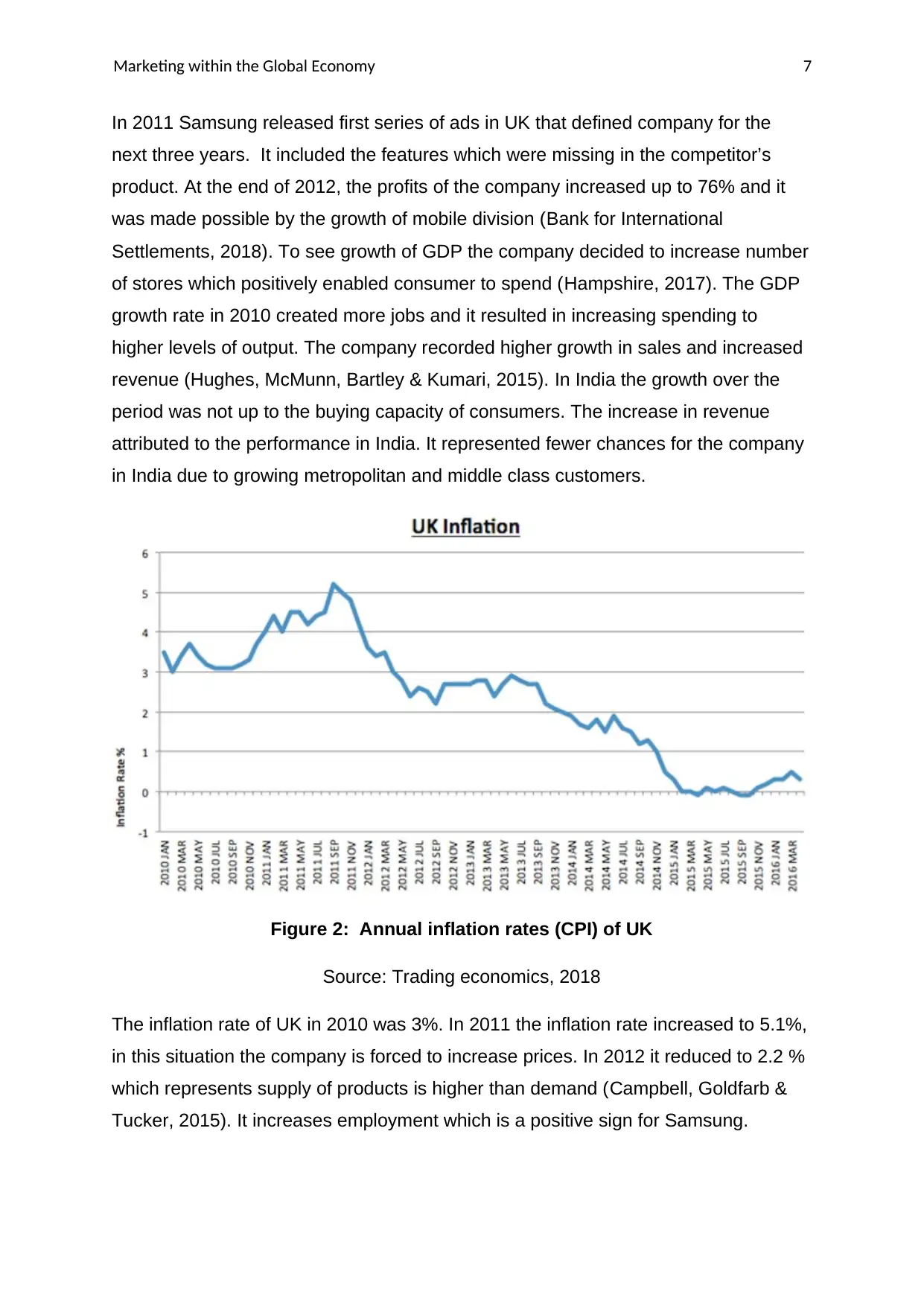
Marketing within the Global Economy 7
In 2011 Samsung released first series of ads in UK that defined company for the
next three years. It included the features which were missing in the competitor’s
product. At the end of 2012, the profits of the company increased up to 76% and it
was made possible by the growth of mobile division (Bank for International
Settlements, 2018). To see growth of GDP the company decided to increase number
of stores which positively enabled consumer to spend (Hampshire, 2017). The GDP
growth rate in 2010 created more jobs and it resulted in increasing spending to
higher levels of output. The company recorded higher growth in sales and increased
revenue (Hughes, McMunn, Bartley & Kumari, 2015). In India the growth over the
period was not up to the buying capacity of consumers. The increase in revenue
attributed to the performance in India. It represented fewer chances for the company
in India due to growing metropolitan and middle class customers.
Figure 2: Annual inflation rates (CPI) of UK
Source: Trading economics, 2018
The inflation rate of UK in 2010 was 3%. In 2011 the inflation rate increased to 5.1%,
in this situation the company is forced to increase prices. In 2012 it reduced to 2.2 %
which represents supply of products is higher than demand (Campbell, Goldfarb &
Tucker, 2015). It increases employment which is a positive sign for Samsung.
In 2011 Samsung released first series of ads in UK that defined company for the
next three years. It included the features which were missing in the competitor’s
product. At the end of 2012, the profits of the company increased up to 76% and it
was made possible by the growth of mobile division (Bank for International
Settlements, 2018). To see growth of GDP the company decided to increase number
of stores which positively enabled consumer to spend (Hampshire, 2017). The GDP
growth rate in 2010 created more jobs and it resulted in increasing spending to
higher levels of output. The company recorded higher growth in sales and increased
revenue (Hughes, McMunn, Bartley & Kumari, 2015). In India the growth over the
period was not up to the buying capacity of consumers. The increase in revenue
attributed to the performance in India. It represented fewer chances for the company
in India due to growing metropolitan and middle class customers.
Figure 2: Annual inflation rates (CPI) of UK
Source: Trading economics, 2018
The inflation rate of UK in 2010 was 3%. In 2011 the inflation rate increased to 5.1%,
in this situation the company is forced to increase prices. In 2012 it reduced to 2.2 %
which represents supply of products is higher than demand (Campbell, Goldfarb &
Tucker, 2015). It increases employment which is a positive sign for Samsung.
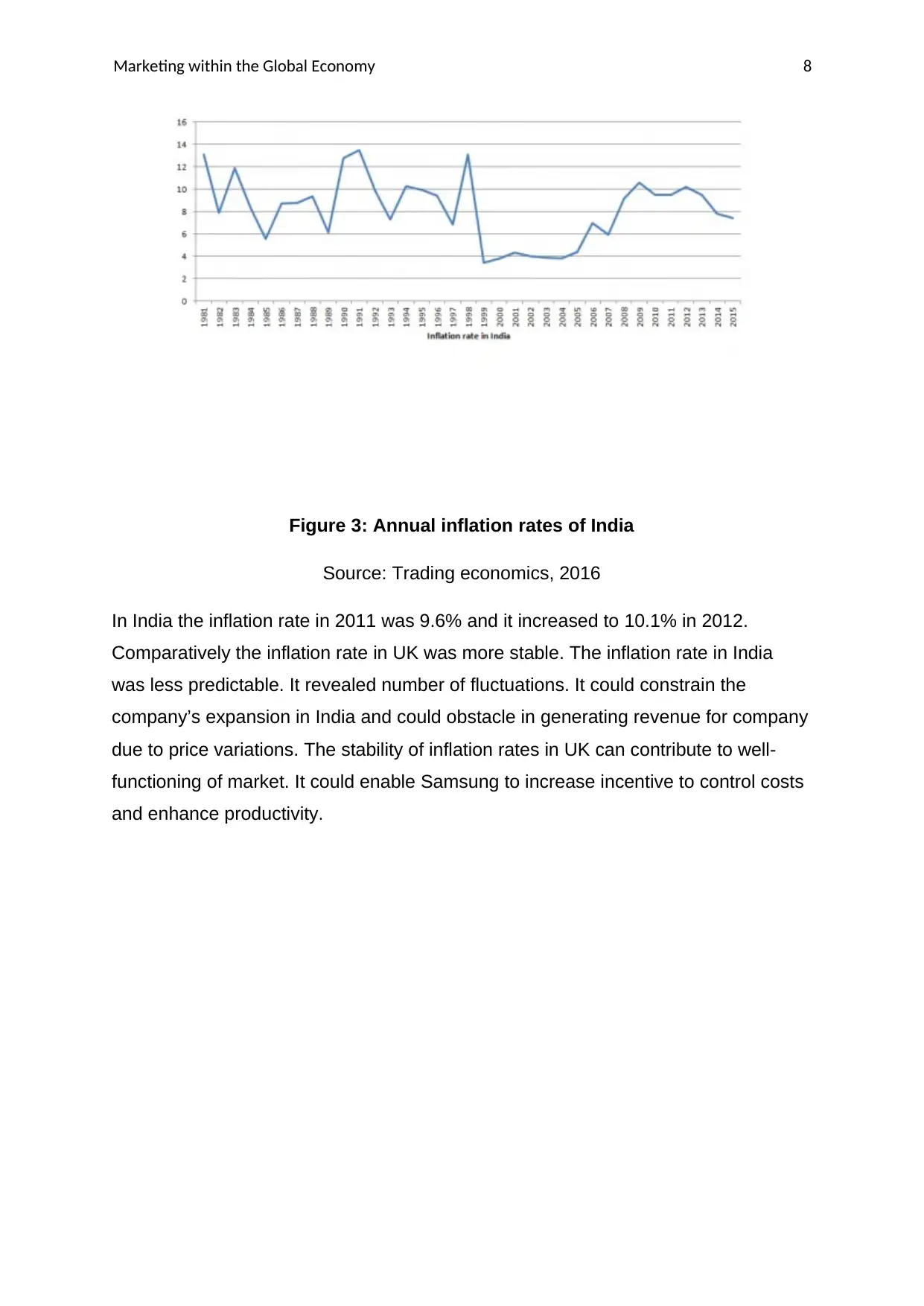
Marketing within the Global Economy 8
Figure 3: Annual inflation rates of India
Source: Trading economics, 2016
In India the inflation rate in 2011 was 9.6% and it increased to 10.1% in 2012.
Comparatively the inflation rate in UK was more stable. The inflation rate in India
was less predictable. It revealed number of fluctuations. It could constrain the
company’s expansion in India and could obstacle in generating revenue for company
due to price variations. The stability of inflation rates in UK can contribute to well-
functioning of market. It could enable Samsung to increase incentive to control costs
and enhance productivity.
Figure 3: Annual inflation rates of India
Source: Trading economics, 2016
In India the inflation rate in 2011 was 9.6% and it increased to 10.1% in 2012.
Comparatively the inflation rate in UK was more stable. The inflation rate in India
was less predictable. It revealed number of fluctuations. It could constrain the
company’s expansion in India and could obstacle in generating revenue for company
due to price variations. The stability of inflation rates in UK can contribute to well-
functioning of market. It could enable Samsung to increase incentive to control costs
and enhance productivity.
⊘ This is a preview!⊘
Do you want full access?
Subscribe today to unlock all pages.

Trusted by 1+ million students worldwide
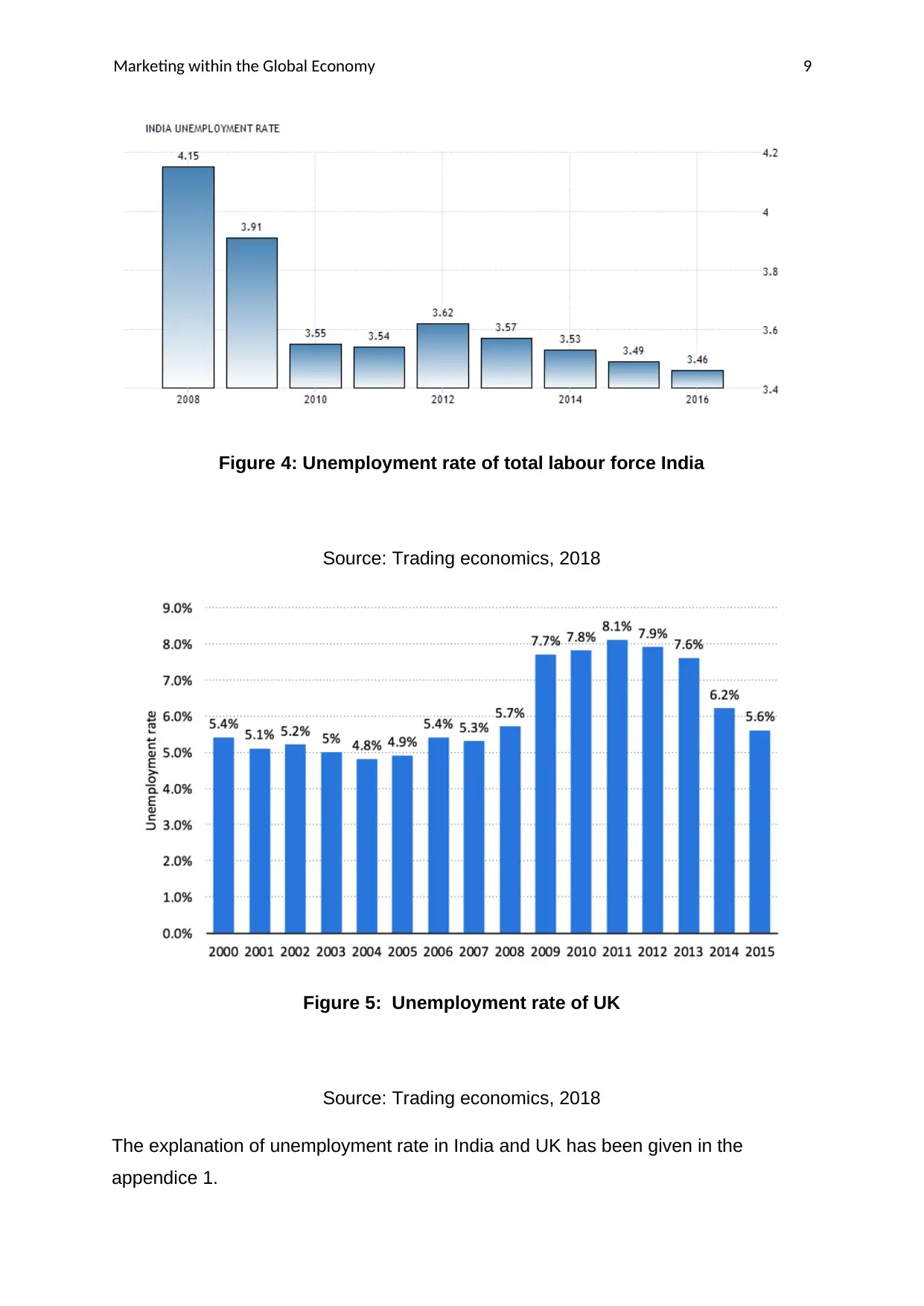
Marketing within the Global Economy 9
Figure 4: Unemployment rate of total labour force India
Source: Trading economics, 2018
Figure 5: Unemployment rate of UK
Source: Trading economics, 2018
The explanation of unemployment rate in India and UK has been given in the
appendice 1.
Figure 4: Unemployment rate of total labour force India
Source: Trading economics, 2018
Figure 5: Unemployment rate of UK
Source: Trading economics, 2018
The explanation of unemployment rate in India and UK has been given in the
appendice 1.
Paraphrase This Document
Need a fresh take? Get an instant paraphrase of this document with our AI Paraphraser
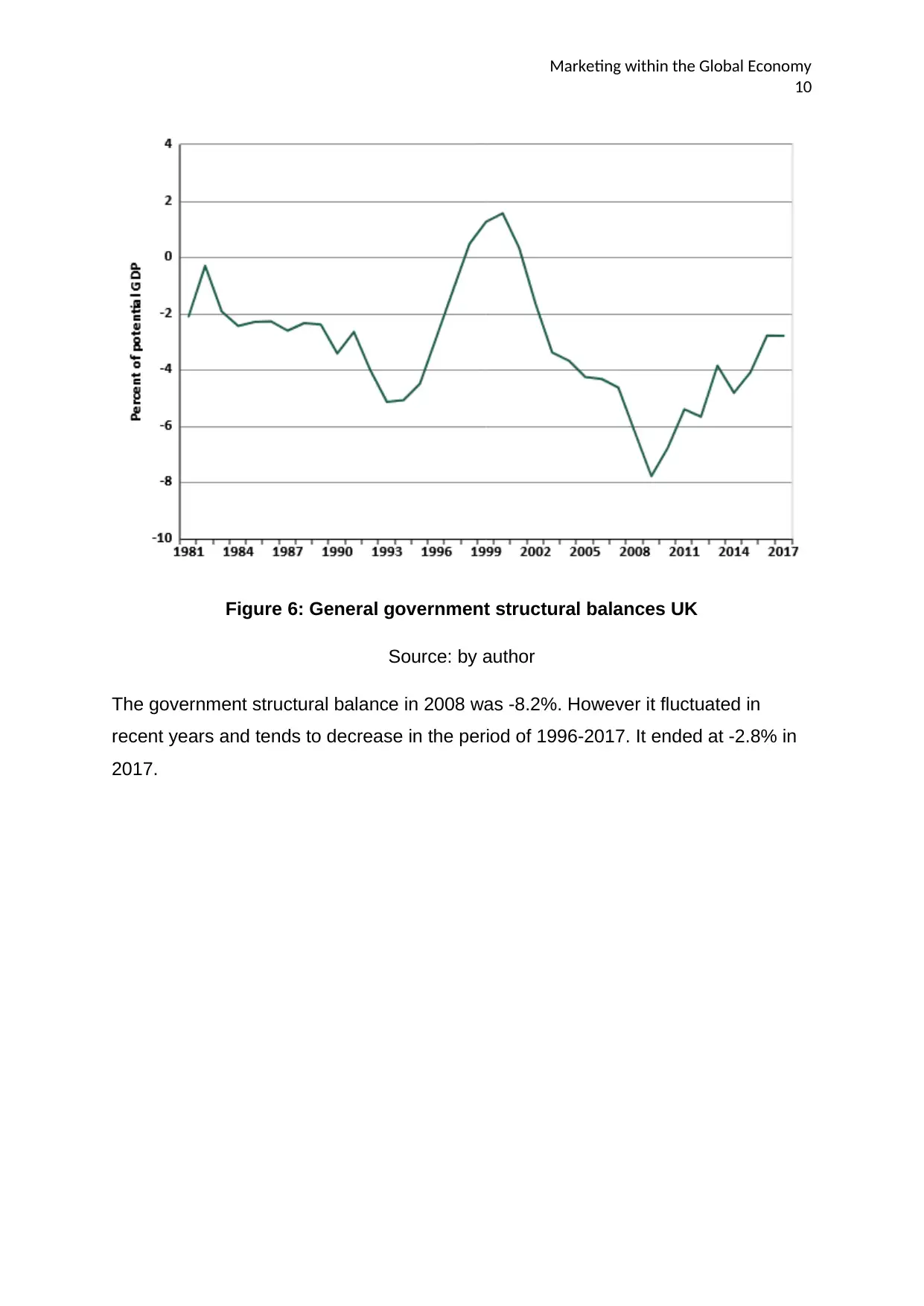
Marketing within the Global Economy
10
Figure 6: General government structural balances UK
Source: by author
The government structural balance in 2008 was -8.2%. However it fluctuated in
recent years and tends to decrease in the period of 1996-2017. It ended at -2.8% in
2017.
10
Figure 6: General government structural balances UK
Source: by author
The government structural balance in 2008 was -8.2%. However it fluctuated in
recent years and tends to decrease in the period of 1996-2017. It ended at -2.8% in
2017.
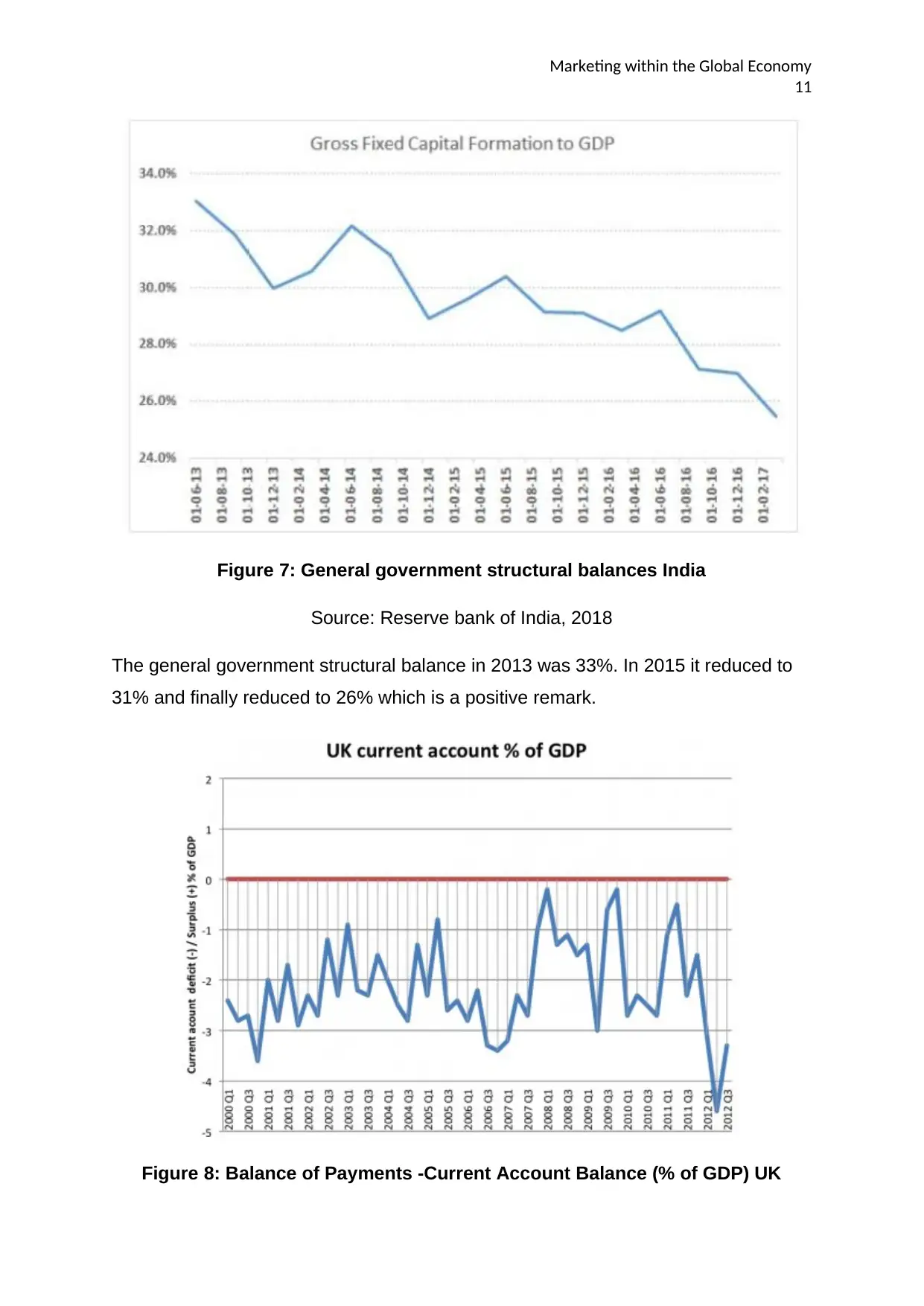
Marketing within the Global Economy
11
Figure 7: General government structural balances India
Source: Reserve bank of India, 2018
The general government structural balance in 2013 was 33%. In 2015 it reduced to
31% and finally reduced to 26% which is a positive remark.
Figure 8: Balance of Payments -Current Account Balance (% of GDP) UK
11
Figure 7: General government structural balances India
Source: Reserve bank of India, 2018
The general government structural balance in 2013 was 33%. In 2015 it reduced to
31% and finally reduced to 26% which is a positive remark.
Figure 8: Balance of Payments -Current Account Balance (% of GDP) UK
⊘ This is a preview!⊘
Do you want full access?
Subscribe today to unlock all pages.

Trusted by 1+ million students worldwide
1 out of 23
Related Documents
Your All-in-One AI-Powered Toolkit for Academic Success.
+13062052269
info@desklib.com
Available 24*7 on WhatsApp / Email
![[object Object]](/_next/static/media/star-bottom.7253800d.svg)
Unlock your academic potential
Copyright © 2020–2025 A2Z Services. All Rights Reserved. Developed and managed by ZUCOL.





